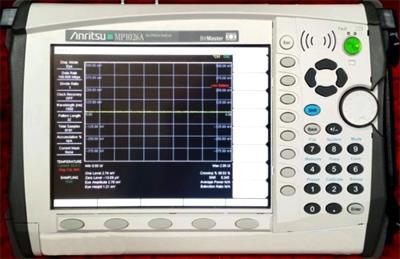
|
|
The Anritsu MP1026A Bit Master Eye Pattern Analyzer offers eye pattern measurements for data rates from 0.1 to 12.5 Gbps in a handheld, rugged, and battery-powered instrument. It is capable of sampling and displaying eye patterns or pulse patterns for high speed signals such as OC192, 10 Gbps Ethernet, and Fiber Channel. It provides convenient measurements for field or lab use and can be an excellent diagnostic tool for identifying sources of noise and jitter that degrade the signal quality. The MP1026A Bit Master has two electrical input channels with 20 GHz of bandwidth. The clock used for measurements could be inputted by the user (0.1 to 12.5 Gbps) or derived from the data (using the optional Clock Recovery Unit 0.1 to 2.7 Gbps and 10 to 12.5 Gbps). An optional optical interface (using an external O/E module) will convert one of the electrical input channels into an optical input channel. The Bit Master allows either one or two channels to be displayed in eye or pulse mode. Time, amplitude, and histogram measurements can be made on either channel. Mask compliance testing can be used to verify whether that the input signal meets specified standards (using the built-in or user defined masks). Time and date stamping of measurement data is automatic. The internal memory provides for the storage and recall of more than 1000 measurement setups. The bright daylight-viewable, high-resolution color liquid crystal display (LCD) provides easy viewing in a variety of lighting conditions.
Specifications.
Horizontal System.
Clock Trigger Frequency: 0.1 to 12.5 GHz.
Clock Trigger Sensitivity: 80 mVp-p, typical (>=1 GHz), 200 mVp-p, typical (<1 GHz).
Maximum Clock Trigger: 2 Vp-p, maximum input before damage.
Jitter, RMS (when measured with a non-divided clock);
5 to 12.5 GHz: 1 ps typical, 1.5 ps maximum,
1 to 5 GHz: 1 ps typical,
0.1 to 1 GHz: 2 ps typical.
Eye Mode Scale Factor: 1 UI minimum full scale.
Pattern Mode Scale Factor: 1 bit minimum full scale.
Vertical System.
Input Range: ±500 mV offset, minimum; ±400 mV dynamic range, minimum; ±2V maximum input before damage. Bandwidth (-3dB): DC to 20 GHz, minimum; DC to 25 GHz, typical; Flatness: ±1 dB, typical.
Noise, RMS: 0.75 mV typical, 1.75 mV maximum.
Digital System Sampling Speed: 100 ksamples/sec typical.
Clock Recovery (Option 002): Clock Rates 9.8 to 12.5 GHz, 0.1-2.7 GHz.
Options.
002 - Clock Recovery Unit Option.
003 - Optical Interface Option (requires O/E Conversion Module OEC10G-1A).
|